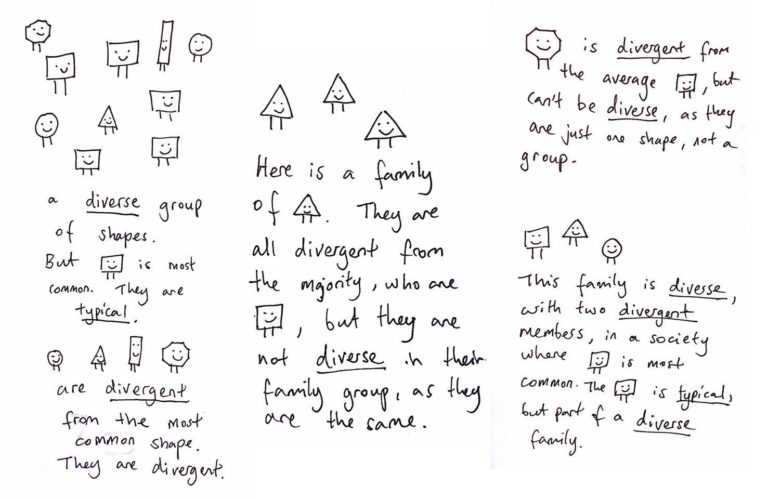- Neurodivergent
Having a brain that differs significantly from the average (for example, autistic, dyslexic or ADHD).
- Neurotypical
Having a more typical brain; belonging to the neurological majority. Compare allistic, which simply means ‘not autistic’.
- Neurodiversity
The diversity of human brains and minds. A group of people with diverse brains is neurodiverse.
The neurodiversity paradigm accepts neurodivergences such as autism and ADHD as natural potentially valuable forms of human diversity, and rejects the idea that there is one kind of ‘normal’ brain that is inherently desirable.
The neurodiversity movement is the political manifestation of this perspective, pushing for full civil rights and inclusion of neurodivergent people.
- Medical model of disability
Disability is the result of individual impairments which prevent people from fully partaking in activities others would take for granted. The deficit model of autism is an example of this, viewing autism in terms of deficits in the autistic person.
- Social model of disability
Disability is the result of interactions between individual differences and social context. A more accommodating society makes disabilities less disabling.
- Double empathy problem
There is a common misconception that autistic people lack empathy, but in fact people in general have difficulty empathising with those who are very different from themselves. Research shows that allistic people find it at least as difficult to empathise with autistics as vice versa.
- Executive function
The psychological ability to get things done.
- Autistic inertia
Inertia is resistance to a change in state. That can mean difficulty getting started, but it also includes difficulty changing tasks or stopping once you’ve started. This is one of the reasons autistic people can find sudden changes of plan distressing.
- Perseveration
The uncontrollable repetition of actions, words or thoughts.
- Monotropism
A cognitive style in which attention tends to be tightly focused – like a torch beam, rather than a lantern light. Posited as a theory of autism, this arguably helps to explain context-blindness, autistic inertia (heavily-invested attention is harder to shift), the atypical connections between ideas made by autistic people, the difficulty processing body language alongside spoken language, the intensity of sensory experiences, and other features of autism.
- Person-first language
Putting the person first when describing people, as in ‘a person with autism’. This is supposed to de-emphasise the condition, and is a style preferred by most professionals.
- Identity-first language
Putting the identity first, as in ‘autistic person’. This is supposed to emphasise that a person cannot be separated from their autism, and is a style preferred by a large majority of autistic people.
- Sensory overload
Many autistic people have trouble tuning out sensory inputs. This can make bright, noisy, smelly environments exhausting and disorienting, which can often lead to the following.
- Meltdown
A response to stress and sensory overload in which an autistic person loses control, usually visibly. Sometimes confused with a tantrum.
- Shutdown
A response to stress and sensory overload in which an autistic person loses some abilities, such as the ability to produce or process speech, or make sense of sensory input.
- Stimming
Self-stimulating behaviour. Includes things like flapping, rocking and fidgeting, often used by autistic people as a form of self-regulation. Sometimes associated with anxiety, most autistics will also have the urge to stim when excited. Suppressing stims can lead to stress and tiredness, and potentially meltdowns or shutdowns.
- Special interest
A passion.

Many of these terms and others are explored in far greater depth in the Stimpunks Glossary. See also Nick Walker’s Neurodiversity: Some Basic Terms & Definitions.
